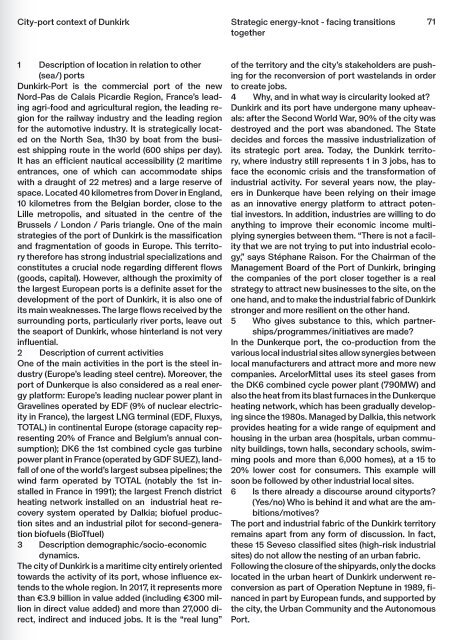Circular City Ports - Workbook
Create successful ePaper yourself
Turn your PDF publications into a flip-book with our unique Google optimized e-Paper software.
<strong>City</strong>-port context of Dunkirk<br />
Strategic energy-knot - facing transitions<br />
together<br />
71<br />
1 Description of location in relation to other<br />
(sea/) ports<br />
Dunkirk-Port is the commercial port of the new<br />
Nord-Pas de Calais Picardie Region, France’s leading<br />
agri-food and agricultural region, the leading region<br />
for the railway industry and the leading region<br />
for the automotive industry. It is strategically located<br />
on the North Sea, 1h30 by boat from the busiest<br />
shipping route in the world (600 ships per day).<br />
It has an efficient nautical accessibility (2 maritime<br />
entrances, one of which can accommodate ships<br />
with a draught of 22 metres) and a large reserve of<br />
space. Located 40 kilometres from Dover in England,<br />
10 kilometres from the Belgian border, close to the<br />
Lille metropolis, and situated in the centre of the<br />
Brussels / London / Paris triangle. One of the main<br />
strategies of the port of Dunkirk is the massification<br />
and fragmentation of goods in Europe. This territory<br />
therefore has strong industrial specializations and<br />
constitutes a crucial node regarding different flows<br />
(goods, capital). However, although the proximity of<br />
the largest European ports is a definite asset for the<br />
development of the port of Dunkirk, it is also one of<br />
its main weaknesses. The large flows received by the<br />
surrounding ports, particularly river ports, leave out<br />
the seaport of Dunkirk, whose hinterland is not very<br />
influential.<br />
2 Description of current activities<br />
One of the main activities in the port is the steel industry<br />
(Europe’s leading steel centre). Moreover, the<br />
port of Dunkerque is also considered as a real energy<br />
platform: Europe’s leading nuclear power plant in<br />
Gravelines operated by EDF (9% of nuclear electricity<br />
in France), the largest LNG terminal (EDF, Fluxys,<br />
TOTAL) in continental Europe (storage capacity representing<br />
20% of France and Belgium’s annual consumption);<br />
DK6 the 1st combined cycle gas turbine<br />
power plant in France (operated by GDF SUEZ), landfall<br />
of one of the world’s largest subsea pipelines; the<br />
wind farm operated by TOTAL (notably the 1st installed<br />
in France in 1991); the largest French district<br />
heating network installed on an industrial heat recovery<br />
system operated by Dalkia; biofuel production<br />
sites and an industrial pilot for second-generation<br />
biofuels (BioTfuel)<br />
3 Description demographic/socio-economic<br />
dynamics.<br />
The city of Dunkirk is a maritime city entirely oriented<br />
towards the activity of its port, whose influence extends<br />
to the whole region. In 2017, it represents more<br />
than €3.9 billion in value added (including €300 million<br />
in direct value added) and more than 27,000 direct,<br />
indirect and induced jobs. It is the “real lung”<br />
of the territory and the city’s stakeholders are pushing<br />
for the reconversion of port wastelands in order<br />
to create jobs.<br />
4 Why, and in what way is circularity looked at?<br />
Dunkirk and its port have undergone many upheavals:<br />
after the Second World War, 90% of the city was<br />
destroyed and the port was abandoned. The State<br />
decides and forces the massive industrialization of<br />
its strategic port area. Today, the Dunkirk territory,<br />
where industry still represents 1 in 3 jobs, has to<br />
face the economic crisis and the transformation of<br />
industrial activity. For several years now, the players<br />
in Dunkerque have been relying on their image<br />
as an innovative energy platform to attract potential<br />
investors. In addition, industries are willing to do<br />
anything to improve their economic income multiplying<br />
synergies between them. “There is not a facility<br />
that we are not trying to put into industrial ecology,”<br />
says Stéphane Raison. For the Chairman of the<br />
Management Board of the Port of Dunkirk, bringing<br />
the companies of the port closer together is a real<br />
strategy to attract new businesses to the site, on the<br />
one hand, and to make the industrial fabric of Dunkirk<br />
stronger and more resilient on the other hand.<br />
5 Who gives substance to this, which partnerships/programmes/initiatives<br />
are made?<br />
In the Dunkerque port, the co-production from the<br />
various local industrial sites allow synergies between<br />
local manufacturers and attract more and more new<br />
companies. ArcelorMittal uses its steel gases from<br />
the DK6 combined cycle power plant (790MW) and<br />
also the heat from its blast furnaces in the Dunkerque<br />
heating network, which has been gradually developing<br />
since the 1980s. Managed by Dalkia, this network<br />
provides heating for a wide range of equipment and<br />
housing in the urban area (hospitals, urban community<br />
buildings, town halls, secondary schools, swimming<br />
pools and more than 6,000 homes), at a 15 to<br />
20% lower cost for consumers. This example will<br />
soon be followed by other industrial local sites.<br />
6 Is there already a discourse around cityports?<br />
(Yes/no) Who is behind it and what are the ambitions/motives?<br />
The port and industrial fabric of the Dunkirk territory<br />
remains apart from any form of discussion. In fact,<br />
these 15 Seveso classified sites (high-risk industrial<br />
sites) do not allow the nesting of an urban fabric.<br />
Following the closure of the shipyards, only the docks<br />
located in the urban heart of Dunkirk underwent reconversion<br />
as part of Operation Neptune in 1989, financed<br />
in part by European funds, and supported by<br />
the city, the Urban Community and the Autonomous<br />
Port.


















